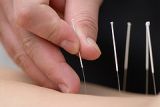Acupuncture (Zhen Fa)
Acupuncture (Zhen Fa):

The first recorded success of acupuncture (zhen fa) dates from about 400 to 300 BC when a Chinese physician, Bian Que, revived a dying man from a coma. The earliest needles date back to the Paleolithic age and were crafted out of stone. During the Neolithic period, needles were made out of bone, later, of bamboo, gold and silver, and today, most commonly of stainless steel. At the early stages of acupuncture, nine different needles (jiu zhen) were used, but today, many more needles, measuring from 2.5 cm (1 in) to 30.5 cm (1 ft) are used.
Stimulating or releasing qi at various acupoints along the body’s meridians is the basis of acupuncture therapy. Acupuncture is widely accepted as an effective form of pain relief. A list of disorders that acupuncture treats effectively, published by the WHO, includes digestive complaints, gynaecological ailments, neurological problems and respiratory illnesses. Western medicine explains it as a method in which pain receptors are blocked, stimulating the nervous system, blood circulation and the production of endorphins. The overall effect can be numbing and comforting.
Needle insertion is quick and usually painless. Needles may be inserted into various acupoints in the area of pain or problem, or acupoints that lie on the associated meridian pathway. Various techniques will then be used to either sedate or disperse qi, and to supply and tone it. These techniques include rotating, lifting; lowering and even vibrating the needle, and they are sometimes synchronized with the patient’s breath. The needles are removed immediately, or kept in place for a few minutes to half an hour to provide maximum relief.